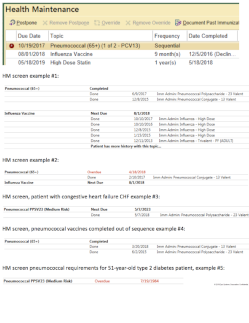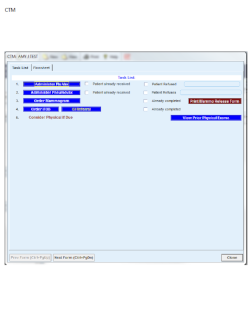IT / Documentation: Level 1
Standardize documentation in EHR
Determine opportunities to standardize documentation in the electronic health record (EHR) to reduce staff workload, ensure accuracy of data, and improve data utilization. Ensure improvements are informed by relevant stakeholders, executed with the help of internal and external IT experts, and incorporated into staff training.
Documentation is a vital step in vaccine administration. Providers require up-to-date, easily understood information to guide patient care, and organizations need accessible, actionable data to track vaccination rates, gaps in care, and progress towards established goals. To standardize vaccine documentation in your EHR, follow the steps below.
Step 1:
Convene stakeholders to review existing EHR workflows
Assemble stakeholders who can provide insights into how the EHR is currently utilized in immunization workflows, including:
- Your Rise to Immunize™ team
- Frontline providers and staff
- Internal IT experts
- External IT experts (e.g., those associated with your EHR vendor)
- Staff with specialized knowledge of billing and coding for vaccinations (if they are outside of your core team)
Be sure to solicit insights and feedback from frontline providers and staff throughout the process, as they feel the greatest impact from EHR changes and are best positioned to advise on how to reduce any disruption to existing clinical workflows. In addition, leadership buy-in is often necessary when significant changes to an organization’s EHR are proposed, so engage your Chief Medical Officer, Chief Quality Officer, and others as needed.
Step 2:
Identify areas for improvement in your EHR
Review the information currently captured in your EHR. Keep in mind what is recorded, when and how it is entered and captured, and who is expected to record immunization information. Be sure to consult any existing resources that can inform your documentation needs, including vaccination standing orders, back-office orientation materials, and immunization protocols for practice. Consider the following questions as you identify areas for improvement:
- Is there anything that should be captured in the EHR that currently is not? Is there anything that is captured that your team is not using?
- Are staff entering data consistently? If not, how can you promote standardization?
- What information is captured in unstructured fields? Would there be a benefit to capturing any of this information in a structured field?
- Are there ways to save staff time when entering data without sacrificing accuracy?
- How can you structure EHR information to more easily incorporate anticipated updates to vaccine guidelines or products?
Step 3:
Update your EHR
Work with your internal IT department as well as your EHR vendor to determine how to best leverage your EHR to capture immunization data. Updates to EHR systems can take time, so plan accordingly when setting goals and timelines. Consider some of the best practices listed below.
Use existing features. Many EHR systems have built-in features that can increase efficiency, accuracy, and standardization. For example, drop-down menus and pre-populated fields can standardize nomenclature across generic and brand vaccine names. A searchable dictionary, another commercially available tool, can help users find data like vaccination names and brands.
Increase the number of structured data fields. Data in tables, rows, and columns are easier to access and analyze than open-text fields. For example, explore tracking vaccine declinations in a structured field rather than an open notes field.
Leverage other technologies. Organizations can use bar code systems, like those used in grocery stores, to automate the process of recording data about specific vaccines. This enables your team to apply special stickers and scan vials as opposed to manually entering information.
Step 4:
Train staff on EHR changes
Once changes are made, be sure to train staff accordingly. Incorporate changes to the vaccine documentation process into staff and provider education where applicable.

Health Maintenance Report
Ochsner Health
Provides an example of a patient immunization health maintenance report within an electronic medical record. The report includes documentation of past vaccinations and highlights overdue vaccinations.
View Tool
Clinical Task List
Westmed Medical Group, P.C.
Offers an example of a task list for preventive care services, including vaccinations, within a patient’s electronic medical record.
View ToolCampaign Planks
Provider & Staff Education
Clinical Support
IT / Documentation
Patient Education
